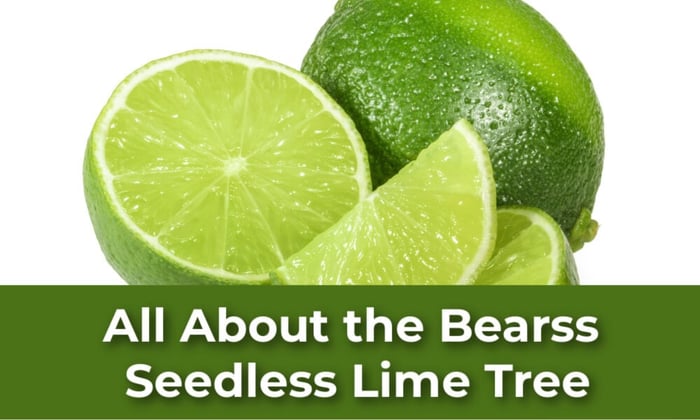Table of Contents
All About the Kishu Mandarin
What is a Kishu Mandarin?
The Kishu mandarin tree grows mandarin fruit that is very small with a thin peel. They are small enough to fit several in the palm of your hand. Kishu mandarins are prized for their exceptionally sweet and juicy flavor. They are known for being one of the sweetest citrus fruits, with a delightful balance of sweetness and acidity. The fruit has a thin, easy-to-peel skin and is typically seedless, making it a popular choice for snacking and fresh eating.
Fun Fact: The Kishu Mandarin earned celebrity status in the citrus world when Alice Waters, founder of the famed Chez Panisse restaurant, praised them for their clean, intense flavor and often features them in fruit-forward desserts and salads.
The History of the Kishu Mandarin:
The Kishu Mandarin is believed to have originated in China, where it has been cultivated for over a thousand years. It’s part of the "Citrus kinokuni" family, which is a group of small, seedless mandarins. Historical records from the Tang and Song dynasties mention similar small, sweet citrus varieties grown in southern China. These ancient mandarins were prized for their balance of sugar and acidity, easy peelability, and delightful fragrance.
Around the 8th to 10th century, the Kishu made its way from China to Japan, where it found a perfect climate in the Kii Province, which is modern-day Wakayama Prefecture, formerly called Kishū (紀州). That’s where the name “Kishu” comes from.
In Japan, the fruit was refined over centuries of careful breeding and cultural reverence. It became one of the most prized varieties of mikan (Japanese mandarins). Kishu mandarins were once so highly valued that they were reserved for the Imperial Family and were considered a symbol of good luck and prosperity. Even today, Japan still reveres this tiny fruit for its quality, and Kishu mikan remains popular during Japanese New Year celebrations.
Kishu mandarins were introduced to the United States in the 1990s, primarily through specialty growers and citrus enthusiasts interested in rare and heirloom varieties. Four Winds Growers and other specialty nurseries helped make them more widely available for home growers and small farms.
Their small size, similar to a golf ball, seedless flesh, and rich, honey-like flavor quickly won over American citrus lovers. Commercially, they’re not grown on the same scale as varieties like Clementines or Satsumas, mostly because of their small size and fragility. But among citrus collectors, farmers' market shoppers, and backyard growers, Kishu mandarins are a beloved treasure.
Growing a Kishu Mandarin Tree at home
Kishu mandarins usually ripen in the late fall or early winter, typically between November and January. The exact ripening time may vary depending on the climate and growing conditions of your region.
The Kishu mandarin tree is known for their cold hardiness, making them suitable for cultivation in various climates. They are cold-hardy down to around 32 degrees Fahrenheit. However, they thrive best in warmer regions. The trees are typically small and compact, which makes them a good choice for home gardeners with limited space. Best for zones 9-11 for in-ground growing. Outside of those zones, you can successfully grow your tree in a container and so it is easier to protect it from extreme weather temperatures.
1. Selecting the Right Pot:
Choose a container with very good drainage. A 10-14” pot is typically suitable for a young tree. Pots with attached saucers are not recommended, as they can keep the roots wet for too long.
2. Soil Mix:
Use a well-draining, chunky potting mix, such as our Primo potting mix. Citrus trees prefer slightly acidic soil.
3. Planting in the ground:
For in-ground planting, plant the Kishu Mandarin tree in a prepared area about 3x the diameter of the pot, and as deep as possible. That soil should be well-draining and loose, allowing for root growth. To plant your tree, dig a hole twice the size of the rootball. Plant at the same depth as the pot, keeping the crown of the roots just above the soil line. Water thoroughly after planting.
4. Location:
Place the potted tree in a location with plenty of sunlight, preferably south facing. Kishu mandarins require at least 6-8 hours of direct sunlight per day.
5. Watering:
Keep the soil consistently moist but not waterlogged. Water when the top inch of soil is dry. Be sure to allow excess water to drain from the pot.
6. Fertilizing:
Use a balanced citrus fertilizer, such as G&B Organics Citrus and Fruit Tree Fertilizer or Romeo Fertilizer according to the package instructions, typically every month during the growing season (spring and summer). Reduce or stop fertilizing in late fall and winter.
7. Pruning:
In the spring, prune the tree as needed to maintain its shape and remove dead or damaged branches. Throughout the year, you may remove dead or diseased branches if necessary. (Click here to read about pruning your citrus tree)
8. Protection from Cold:
If you live in a region with cold winters, be prepared to protect your potted Kishu mandarin from freezing temperatures, as it is not frost tolerant. You can bring it indoors for longer periods or cover it with frost cloth during short cold spells.(Click here to read about Overwintering Your Citrus Trees)
9. Harvesting:
Kishu mandarins can be harvested once they turn a bright orange color. This is in the early winter in most regions. They should come off the tree easily and also be easy to peel, completely orange, and, upon tasting, their sweet flavor is a good indicator of ripeness.
Growing Kishu Mandarin trees is not difficult, but it does require your regular attention and care. Provide it with everything that it needs, and you can successfully grow a Kishu mandarin tree in a pot and enjoy the delicious, sweet fruit it produces for many years to come.
$65.00
--OVERVIEW-- Mid-Season Ripening This cute little mandarin tree produces very sweet, seedless, easy-to-peel fruit about the size of a walnut. This variety of mandarin is popular in Japan. Since the fruit is small and soft, it is not grown… read moreKishu Semi-Dwarf Mandarin Tree





